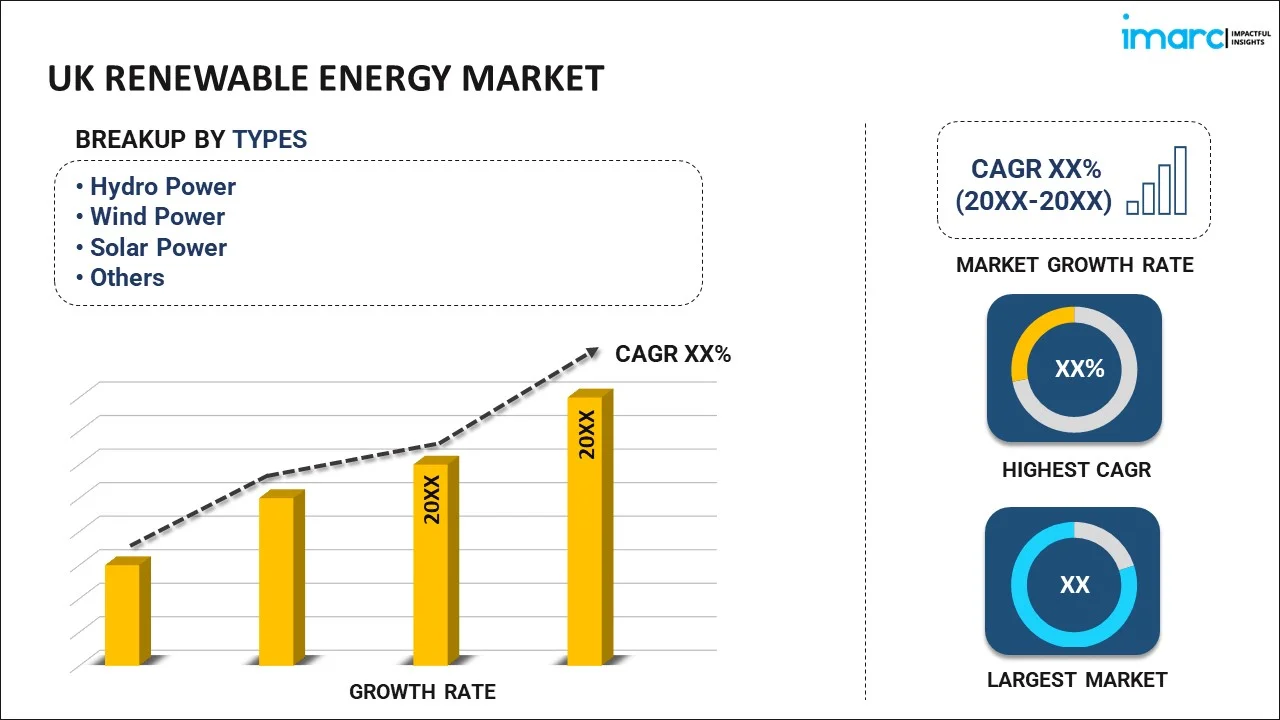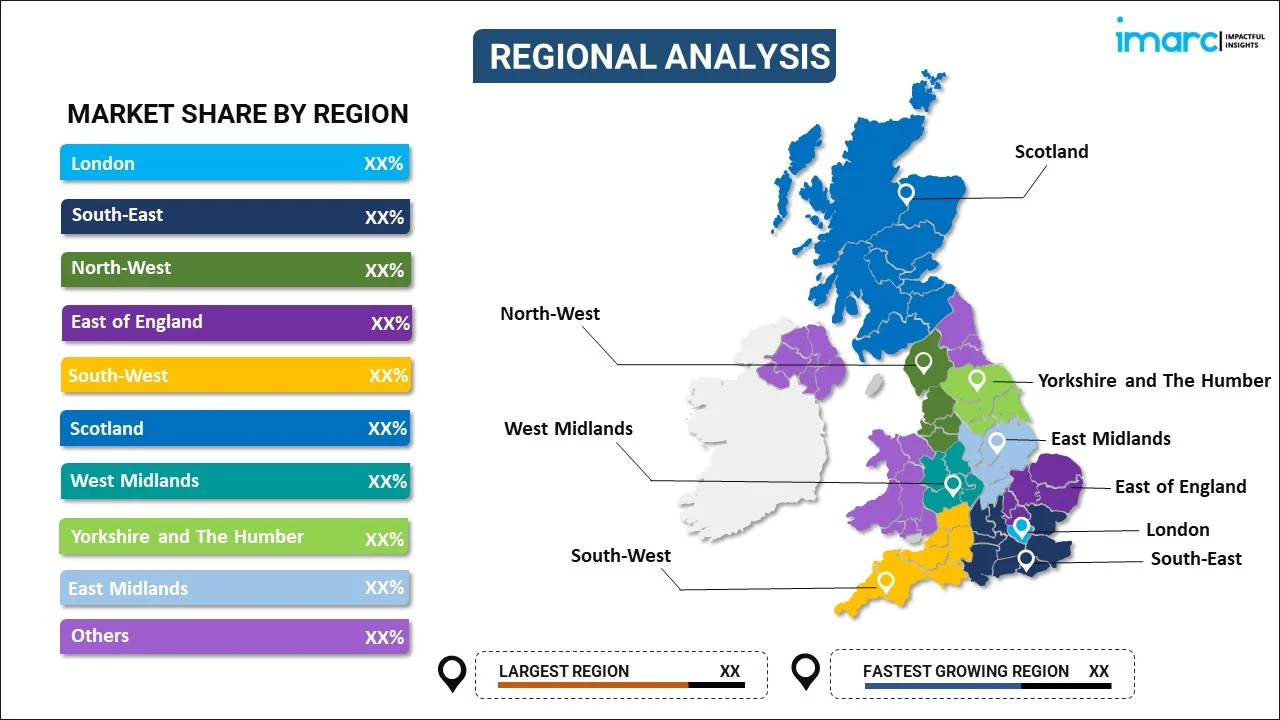
UK Renewable Energy Market Report by Type (Hydro Power, Wind Power, Solar Power, Bioenergy, and Others), End User (Industrial, Residential, Commercial), and Region 2024-2032
UK Renewable Energy Market Overview:
The UK renewable energy market is projected to exhibit a growth rate (CAGR) of 9.50% during 2024-2032. The market is rapidly growing mainly driven by significant investments in offshore wind, solar energy and green hydrogen production. Key trends include technological advancements, expanded energy storage solutions and supportive government policies. These initiatives position the UK as a leader in the transition to sustainable energy sources.
|
Report Attribute
|
Key Statistics
|
|---|---|
|
Base Year
|
2023 |
|
Forecast Years
|
2024-2032
|
|
Historical Years
|
2018-2023
|
| Market Growth Rate (2024-2032) | 9.50% |
UK Renewable Energy Market Trends:
Expansion of Offshore Wind Power
The expansion of offshore wind power is a major trend in the UK renewable energy market, driven by significant investments and strategic initiatives. The UK is a global leader in offshore wind capacity, continuously increasing its installations with numerous large-scale projects in development and construction. This growth is supported by favorable government policies and substantial financial commitments, aiming to achieve ambitious renewable energy targets. For instance, according to a report published by the Wind Europe, the United Kingdom aims for 50 GW of offshore wind by 2030 with current capacity at 14.7 GW. Policy adjustments including a 66% increase in the ceiling price for the sixth round of CfD auctions are expected to boost progress. Notably, RWE and Vattenfall reached an agreement on the Norfolk Zone incorporating three wind farms with a combined 4.2 GW capacity. Additionally, Ørsted's Hornsea 3 project set for completion in 2027 will power 3.3 million households. Technological advancements are playing a crucial role in this expansion. Innovations in turbine technology, such as larger and more efficient blades, are enabling higher energy output from each installation. Additionally, advancements in installation techniques, including the use of floating wind farms, are opening up new areas for development, particularly in deeper waters. These technological improvements are not only enhancing the efficiency and reliability of offshore wind farms but also significantly reducing costs, making offshore wind a more competitive and sustainable energy source for the future.
Rising Investment in Hydrogen Energy
Investment in hydrogen energy, particularly green hydrogen, is a key trend in the UK renewable energy market. Green hydrogen is produced by electrolysis, using renewable energy sources like wind and solar to split water into hydrogen and oxygen, resulting in zero carbon emissions. The UK government and private sector are making significant investments in green hydrogen production to support the transition to a low-carbon economy. This focus on green hydrogen is complemented by the development of comprehensive hydrogen infrastructure. New production facilities are being built to scale up the supply of green hydrogen, while refueling stations are expanding to support hydrogen-powered vehicles. For instance, according to a report published by the Government of UK in Feb 2024, The UK government is investing over £21 million in 7 projects to boost low carbon hydrogen production aiming to create green fuel for transportation and local businesses. These projects spread across Suffolk to Shetland will include the development of new hydrogen production plants as well as the establishment of hydrogen refueling stations. These efforts are driven by the UK’s commitment to achieving net-zero emissions by 2050 and the potential of hydrogen to provide a versatile, clean energy solution.
UK Renewable Energy Market News:
In November 2023, governments of the UK and Germany formed a new partnership to advance renewable energy and enhance energy security. The agreement is signed by the UK Energy Security Secretary and the German Vice Chancellor and aims to boost cooperation in clean technologies and remove regulatory barriers on renewables. The partnership will focus on offshore wind and electricity interconnection knowledge sharing on decarbonization and efforts to limit global warming.
In April 2024, British Gas partnered with Forster Group to expand its solar power and battery storage installations across Scotland, England and Wales. The collaboration aims to help households save 75-90% off their electricity bills through solar panels and batteries. The partnership will increase British Gas's accredited engineers by 55% accelerating the transition to renewable energy. Customers can receive a free consultation for tailored solar panel installation reflecting British Gas and Hive's commitment to decarbonizing homes and reducing energy costs.
UK Renewable Energy Market Segmentation:
IMARC Group provides an analysis of the key trends in each segment of the market, along with forecasts at the country level for 2024-2032. Our report has categorized the market based on type and end user.
Type Insights:

- Hydro Power
- Wind Power
- Solar Power
- Bioenergy
- Others
The report has provided a detailed breakup and analysis of the market based on the type. This includes hydro power, wind power, solar power, bioenergy, and others.
End User Insights:
- Industrial
- Residential
- Commercial
A detailed breakup and analysis of the market based on the end user have also been provided in the report. This includes industrial, residential, and commercial.
Regional Insights:

- London
- South East
- North West
- East of England
- South West
- Scotland
- West Midlands
- Yorkshire and The Humber
- East Midlands
- Others
The report has also provided a comprehensive analysis of all the major regional markets, which include London, South East, North West, East of England, South West, Scotland, West Midlands, Yorkshire and The Humber, East Midlands, and Others.
Competitive Landscape:
The market research report has also provided a comprehensive analysis of the competitive landscape in the market. Competitive analysis such as market structure, key player positioning, top winning strategies, competitive dashboard, and company evaluation quadrant has been covered in the report. Also, detailed profiles of all major companies have been provided.
UK Renewable Energy Market Report Coverage:
| Report Features | Details |
|---|---|
| Base Year of the Analysis | 2023 |
| Historical Period | 2018-2023 |
| Forecast Period | 2024-2032 |
| Units | GW |
| Scope of the Report | Exploration of Historical Trends and Market Outlook, Industry Catalysts and Challenges, Segment-Wise Historical and Future Market Assessment:
|
| Types Covered | Hydro Power, Wind Power, Solar Power, Bioenergy, Others |
| End Users Covered | Industrial, Residential, Commercial |
| Regions Covered | London, South East, North West, East of England, South West, Scotland, West Midlands, Yorkshire and The Humber, East Midlands, Others |
| Customization Scope | 10% Free Customization |
| Post-Sale Analyst Support | 10-12 Weeks |
| Delivery Format | PDF and Excel through Email (We can also provide the editable version of the report in PPT/Word format on special request) |
Key Questions Answered in This Report:
- How has the UK renewable energy market performed so far and how will it perform in the coming years?
- What has been the impact of COVID-19 on the UK renewable energy market?
- What is the breakup of the UK renewable energy market on the basis of type?
- What is the breakup of the UK renewable energy market on the basis of end user?
- What are the various stages in the value chain of the UK renewable energy market?
- What are the key driving factors and challenges in the UK renewable energy?
- What is the structure of the UK renewable energy market and who are the key players?
- What is the degree of competition in the UK renewable energy market?
Key Benefits for Stakeholders:
- IMARC’s industry report offers a comprehensive quantitative analysis of various market segments, historical and current market trends, market forecasts, and dynamics of the UK renewable energy market from 2018-2032.
- The research report provides the latest information on the market drivers, challenges, and opportunities in the UK renewable energy market.
- Porter's five forces analysis assist stakeholders in assessing the impact of new entrants, competitive rivalry, supplier power, buyer power, and the threat of substitution. It helps stakeholders to analyze the level of competition within the UK renewable energy industry and its attractiveness.
- Competitive landscape allows stakeholders to understand their competitive environment and provides an insight into the current positions of key players in the market.
Need more help?
- Speak to our experienced analysts for insights on the current market scenarios.
- Include additional segments and countries to customize the report as per your requirement.
- Gain an unparalleled competitive advantage in your domain by understanding how to utilize the report and positively impacting your operations and revenue.
- For further assistance, please connect with our analysts.
 Inquire Before Buying
Inquire Before Buying
 Speak to an Analyst
Speak to an Analyst
 Request Brochure
Request Brochure
 Request Customization
Request Customization




.webp)




.webp)












